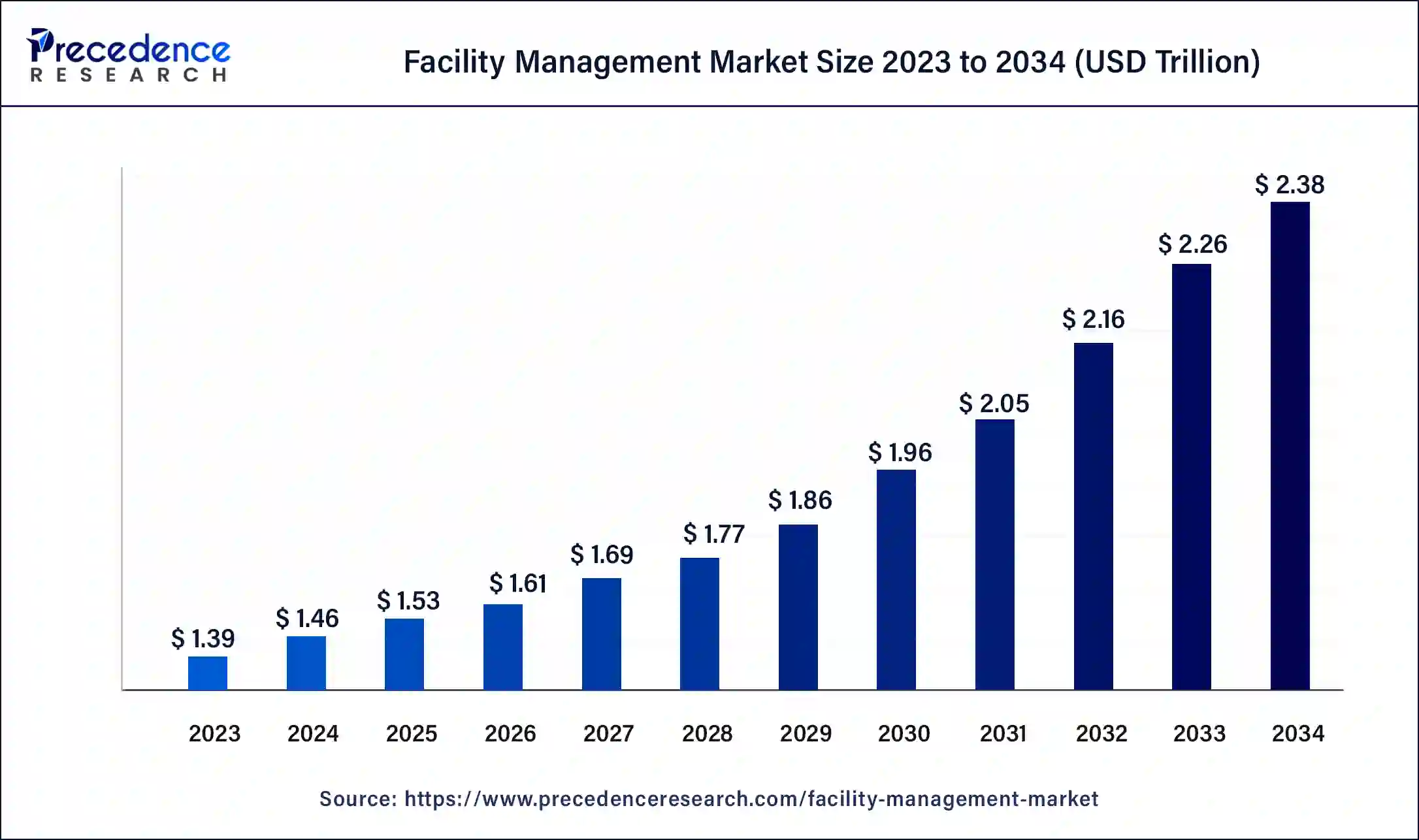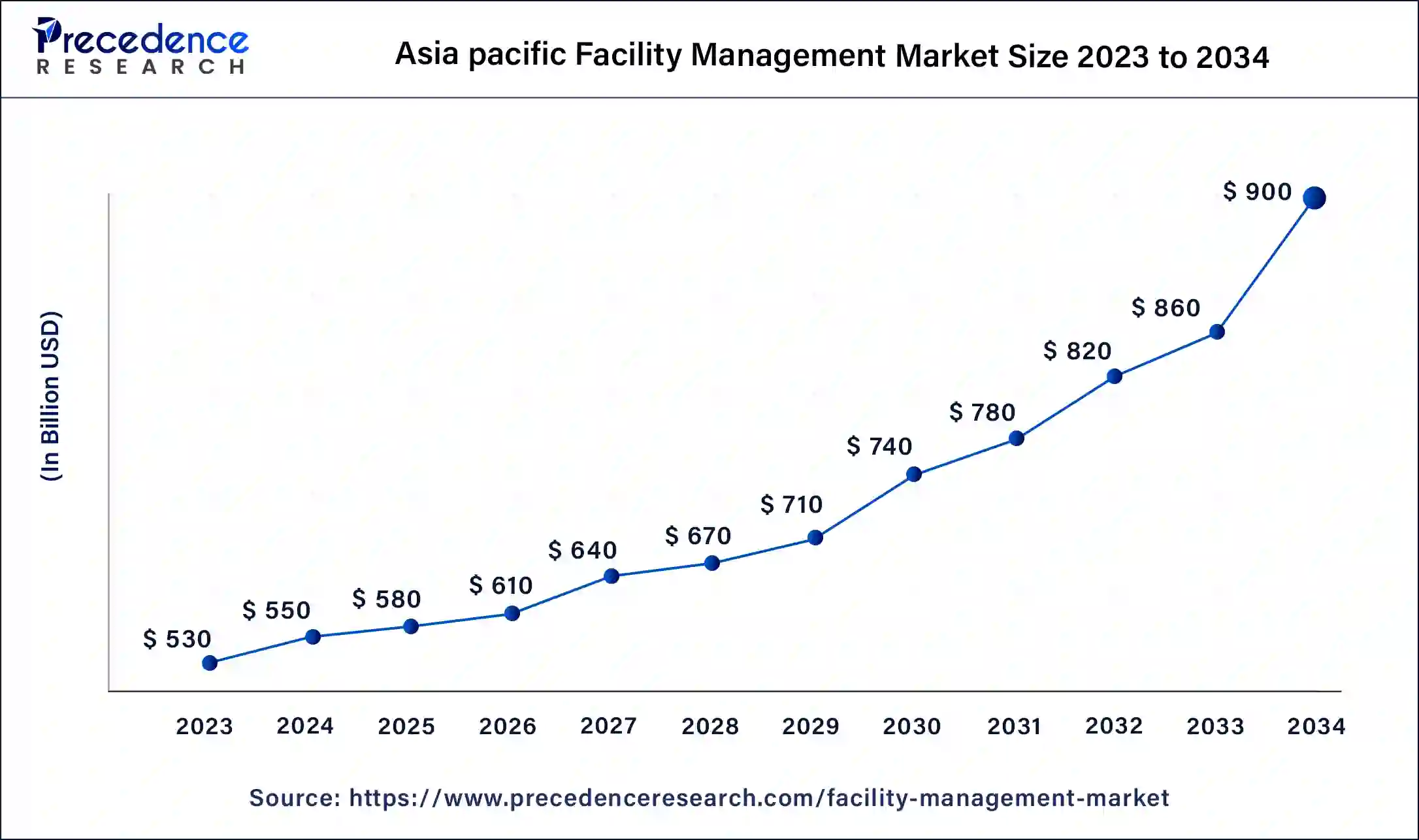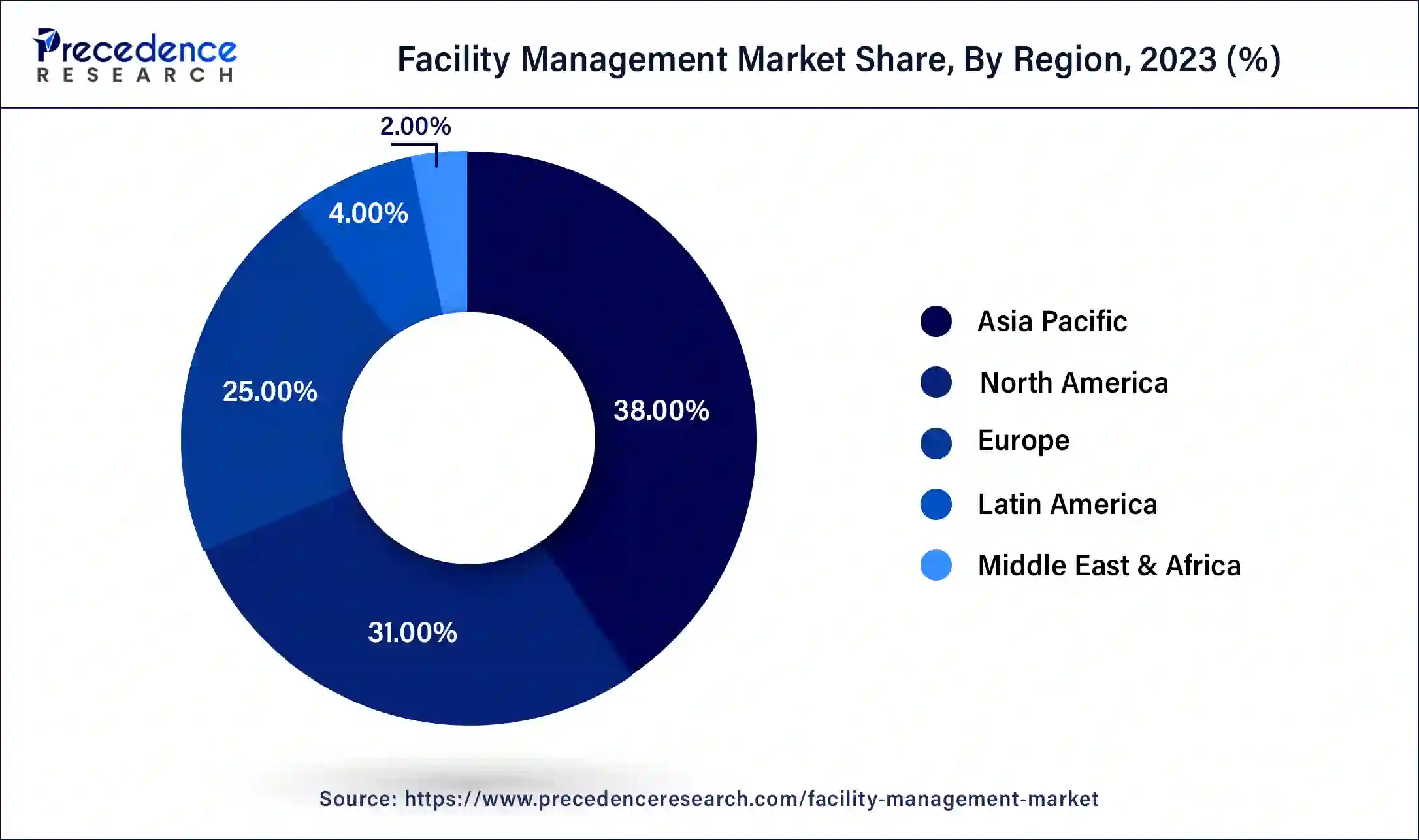August 2024
The global facility management market size was USD 1.39 trillion in 2023, calculated at USD 1.46 trillion in 2024 and is expected to reach around USD 2.38 trillion by 2034, expanding at a CAGR of 5% from 2024 to 2034.
The facility management market size accounted for USD 1.46 trillion in 2024 and is expected to reach around USD 2.38 trillion by 2034, expanding at a CAGR of 5% from 2024 to 2034.

The Asia Pacific facility management market size was estimated at USD 530 billion in 2023 and is predicted to be worth around USD 900 billion by 2034, at a CAGR of 6.1% from 2024 to 2034.

Asia-Pacific dominated the facility management market in 2023. To offer their services to end users and extend their geographical footprint, established important players are focusing on partnering with local players.
North America, on the other hand, is expected to develop at the fastest rate during the forecast period. With the implementation of new technologies such as internet of things, artificial intelligence, robot adoption, and others, the facility management market in North America is predicted to rise steadily.

The facility management encompasses a variety of services and disciplines aimed at ensuring the functionality, comfort, and efficiency of the built environment including buildings, real estate, and infrastructure. The communications management, operations and maintenance, business continuity, and emergency management as well as environmental responsibility and sustainability are all aspects of facility management. The project management, hospitality and human aspects, real estate and property management, and ergonomics are just a few of the topics covered in this course. Outsourcing facility management services allows businesses to better manage their corporate social responsibilities, comply to health and safety regulations and maintain the overall quality of their core operations.
The expansion of the facility management market is being fueled by the rising focus of governments in a number of nations on infrastructure development particularly in the construction of ports, railways, airports, and other infrastructural projects. The facility management market is also predicted to increase due to numerous collaborations with several commercial contractors and various government initiatives involving multinational players. As a result, the facility management market is developing in accordance with the expansion of infrastructure.
Governments in both established and emerging countries are investing in the tourist industry as well as a variety of other industries. These tourism related expenditures are assisting in the construction of new infrastructure, which will help the facility management market to flourish. In addition, cloud-based solutions have provided dependable hosting facility management software that minimizes operating costs, improves security, and facilitates collaboration among diverse teams and subsidiaries located throughout the globe. The data can be accessed at any time and from any location. For the sustainability of the facility management market, all of these advantages have resulted in a growth in the use of cloud-based solutions.
Over the previous two decades, the global penetration of outsourced facility management services has expanded dramatically. Customers nowadays expect their facility management service provider to have a thorough understanding of the company’s goal and the ability to respond to the customer’s individual requirements, which is predicted to drive the global facility management market in the long run. With the growth of the facility management outsourcing market, facility management providers are expanding.
The facility management companies are concentrating their efforts on developing new and inventive methods to make facility assets and services not only relevant but also essential to improving customer experience, business administration, occupational physiology, and supporting their core business. The property management services are tailored to meet the financial goals of property owners in the short and long term. For their customers, service and solution providers create a strategic property operations plan based on a zero-based operating budget and capital plan. The experienced property managers and accounting professionals collaborate closely with engineering sciences staff to monitor and control all running costs in order to get the best potential return on investment.
One of the most important developing facility management market trends is the use of internet of things in facility management. The internet of things uses technology like predictive maintenance to reduce operating expenses while also increasing productivity. The lighting and refrigeration, security and safety alarms, fire suppression systems, and remote monitoring can all be automated via the internet of things. The internet of things solutions is also being offered by a variety of third-party outsourcing organizations such as building management service providers.
The infrastructure investment is a priority for governments in a number of countries. They have begun to make significant investments in the construction of trains and airports. There have been a number of cooperation with a variety of private companies including service providers to keep the infrastructure clean and green. Furthermore, governments are entering into agreements with a number of multinational players to finish and connect their infrastructure both inside and beyond borders. As a result, the facility management market is likely to be driven by the expansion of the infrastructure sector in various nations. Furthermore, service providers all around the world have multiple options for obtaining contracts from the private sector.
| Report Coverage | Details |
| Market Size in 2023 | USD 1.39 Trillion |
| Market Size in 2024 | USD 1.46 Trillion |
| Market Size by 2034 | USD 2.38 Trillion |
| Growth Rate from 2024 to 2034 | CAGR of 5% |
| Largest Market | Asia Pacific |
| Fastest Growing Region | North America |
| Base Year | 2023 |
| Forecast Period | 2024 to 2034 |
| Segments Covered | By Type, By Deployment Mode, By Industry, By Component, and By Organization Size |
| Regions Covered | North America, Europe, Asia-Pacific, Latin America, and Middle East & Africa |
In 2023, the hard services segment dominated the facility management market. The key driver driving the hard services segment is the rapid growth of the building and construction industry as a result of increased urbanization around the world.
The soft services segment, on the other hand, is predicted to develop at the quickest rate in the future years. Increased investments in waste management, wastewater management, energy management, and other green energy management industries have contributed to the growth of the segment.
The real estate segment dominated the facility management market in 2023 with a market share of around 30%. The real estate sector is expected to be driven by continued growth in the building industry around the world over the projected period.
The government industry segment is fastest growing segment of the facility management market in 2023. In the global facility management market, the government sector is predicted to increase at a steady pace. This is due to the government’s emphasis on infrastructure development.
Segments Covered in the Report
By Type
By Component
By Industry
By Deployment Mode
By Organization Size
By Geography
For inquiries regarding discounts, bulk purchases, or customization requests, please contact us at sales@precedenceresearch.com
No cookie-cutter, only authentic analysis – take the 1st step to become a Precedence Research client
August 2024
April 2025
September 2024
November 2024